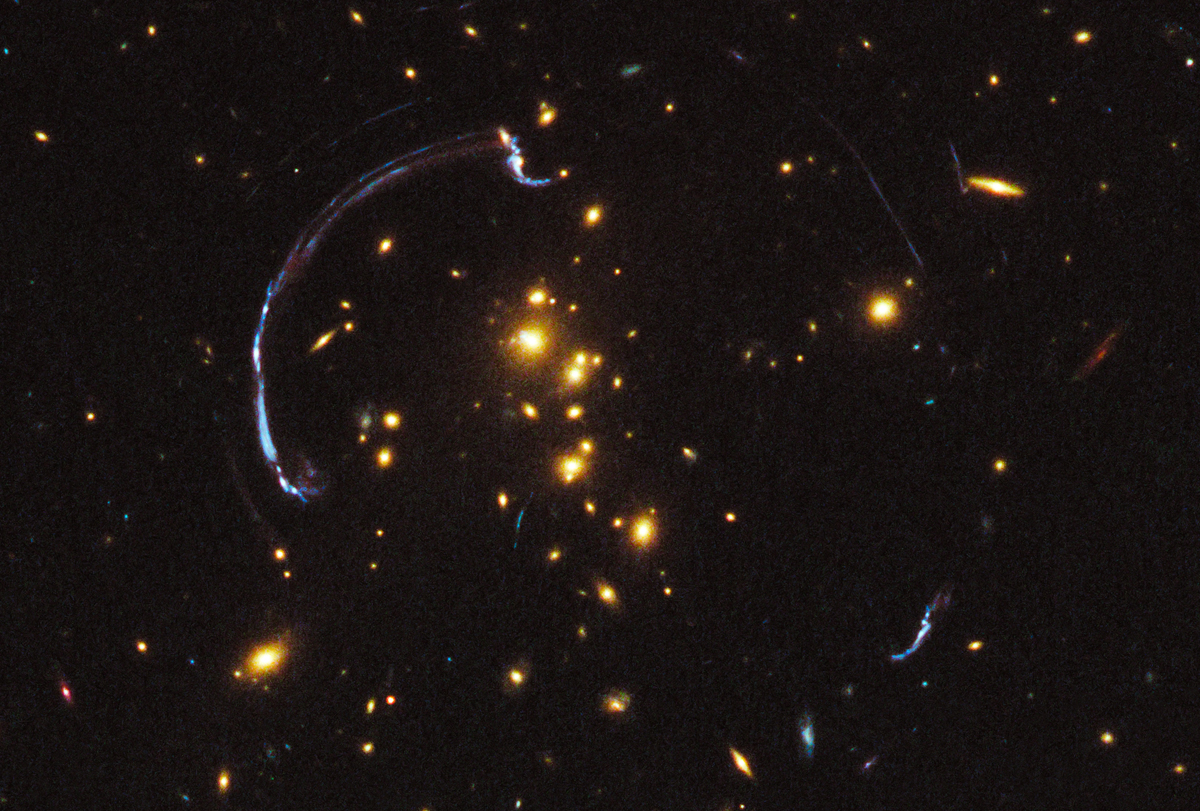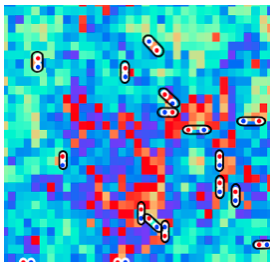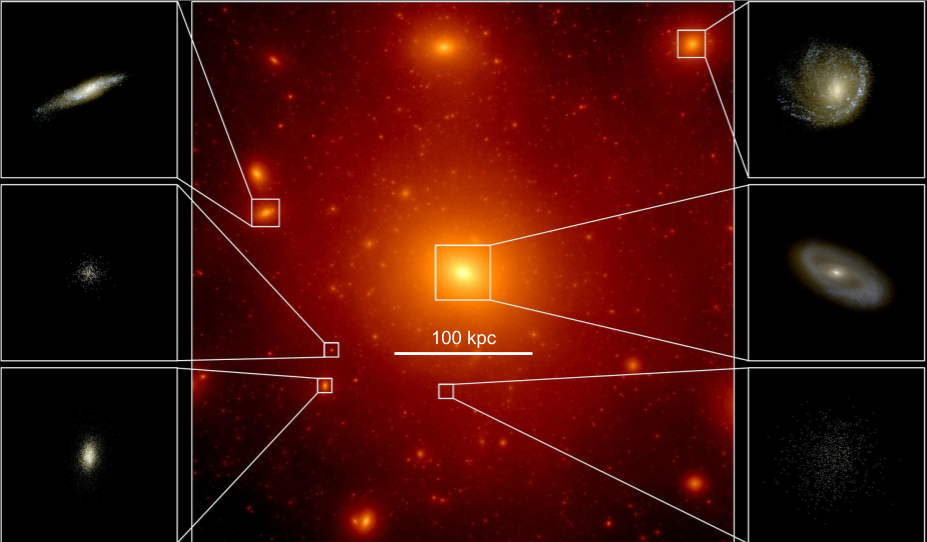 Project Title: Modelling “Cosmic Telescopes
Project Title: Modelling “Cosmic TelescopesMentor: Catie Raney (graduate student, astronomy) & Chuck Keeton (professor, astronomy)
Skills: python – jupyter notebooks (preferred), numpy for reading and manipulating data, matplotlib for making plots
Roughly half of the weeks of the seminar will be spent working on a research project in a very small group with mentors (graduate students, postdocs, or faculty) from the Physics & Astronomy Department. Students: please select your top three choices, and we will sort you into groups based on your choices. Read about the projects below, and follow the link to learn more about your potential mentors.
 Project Title: Modelling “Cosmic Telescopes
Project Title: Modelling “Cosmic Telescopes
Mentor: Catie Raney (graduate student, astronomy) & Chuck Keeton (professor, astronomy)
Skills: python – jupyter notebooks (preferred), numpy for reading and manipulating data, matplotlib for making plots
“A long time ago in a galaxy far, far away.” That phrase made famous by Star Wars is very real for astronomers. Because light takes time to reach us, looking out into the universe means looking back in time. Modern telescopes let us see almost all the way back to the age when stars and galaxies were just being born. But they need a boost from “cosmic telescopes” – massive clusters of galaxies whose gravity bends light and magnifies distant galaxies, making them appear bigger and brighter and therefore easier to detect.
In order to study magnified galaxies, it is necessary to make models that describe how the cosmic telescopes bend and distort light rays. Our team has participated in an international effort to model galaxy clusters observed with the Hubble Space Telescope. A key step is distinguishing between galaxies that are part of a cluster from those that lie in the foreground or background. In this project, you will learn to work with astronomical data, identify cluster member galaxies, estimate their masses, and make different kinds of plots to display your results.
Project Title: The Central Limit Theorem
Mentor: Win Lin (grad, nuclear) & Ron Gilman (prof, nuclear physics)
Skills: simple python coding
The central limit theorem is important in physics because experiments deal with statistical data and understanding of distributions. It is also important in statistical physics when dealing with large numbers of particles. In this project, students will use a random number generator to generate data, and in the limit of large sampling test that the resulting distribution approaches a Gaussian, following the central limit theorem.
 Project Title: Determining the age of a supernova remnant from its size and expansion speed
Project Title: Determining the age of a supernova remnant from its size and expansion speed
Mentor: Prassidha Arunachalam (graduate student, astronomy) & Jack Hughes (professor, astronomy)
Skills: basic python, notebooks
At the end of their lives, stars explode in spectacular fashion, producing supernovae (SN) whose brightness can rival, for a few weeks, the entire light output from the host galaxy. SN explosions rip the star apart, flinging the stellar matter out into the interstellar medium. Drawing on the physics of fluid dynamics, astronomers have developed models that describe the evolution of the size and speed of the material propagating from the site of the explosion. In this project students will write a simple code to evaluate and plot the equations for the time evolution of the radius and speed of the ejected material, called a supernova remnant. Using measurements of the size and rate of expansion of a supernova remnant in a nearby galaxy (the Large Magellanic Cloud), the students will determine the age of the remnant, thereby revealing when the SN explosion occurred.
Project Title: Using Radioactivity to Calibrate Detectors
Mentor: Ivan Lepetic (postdoc, high energy experiment)
Skills: Reading a CSV file, matplotlib numpy, Jupyter notebooks
You’ve heard that radioactivity is dangerous, but did you know it can also be useful? From smoke detectors to nuclear power plants, radioactive isotopes have a variety of useful purposes. In this project, we will use radioactive decays to calibrate a neutrino detector. You will examine the activity of two radioactive isotopes in simulated neutrino detector data and compare to known values to help determine the proper calibration constants for use in future experiments.
Project Title: The Smallest Galaxies in the Universe have Big Stories to Tell
Mentor: Kristy McQuinn (professor, astronomy)
Skills: Python julyter notebooks (preferred; not required) and basic unix commands, reading in table data, basic numpy, matplotlib (plotting), scipy
Our Universe today is filled with galaxies with a diverse set of properties, from the smallest systems that only 1000 times as massive as our Sun to very large systems that are a trillion times as massive. All galaxies started off small when they formed some 13 billion years ago; some grow bigger with time while others remain less massive. While still complex, the low-mass "dwarf" galaxies are some of the simplest of galactic systems and, therefore, are a great laboratory for studying how galaxies form, grow, and evolve. Their low-masses means their survival and evolution has been a tug-of-war between the gravity that binds the systems (i.e., dark matter) and energetic phenomenon that pushes out against the gravity (i.e., the energy of exploding stars within the galaxies or the tidal forces from other nearby galaxies).
In this project, we will study a dwarf galaxy that is relatively close to our Milky Way galaxy. Using imaging of 1000's of the individual stars from the Hubble Space Telescope, we will measure the distance to the galaxy, age-date the stars to determine when the bulk of the galaxy was formed, and determine the galaxy's overall chemical content (traced by iron that is forged in exploding stars).
 Project Title: Phase transitions in two and three dimensional systems
Project Title: Phase transitions in two and three dimensional systems
Mentor: Victor Drouin-Touchette (graduate student, condensed matter theory)
Skills: Python numpy/scipy/matplotlib
The transition of matter from the ordered to the disordered phase is one we understand well in three dimensions – the space we live in. Through the 20th century, increased attention was devoted to two-dimensional materials for their unusual behavior - experimentalists saw the appearance of odd phases that fit neither criteria! Through this project, students will analyze the output of numerical simulations in 2 and 3 dimensions of related models presenting phase transitions and learn to identify those by studying measurements of the order and of the energy. They will then learn what makes 2D so different and explore the Kosterlitz-Thouless phase transition.
Project Title: Resolving Galactic Differences with MaNGA
Mentor: Charlotte Olsen (graduate student, astornomy)
Skills: basic Python -- notebooks, reading data, plotting data
Galaxies come in all shapes and sizes, and each of these has different properties. One way of exploring how galaxies evolve over time is by looking at these properties. The Mapping Nearby Galaxies with APO (MaNGA) allows us state of the art spatially resolved images and spectroscopy with which we can explore the properties which drive galaxy evolution. Our researcher(s) will examine a few galaxies with different morphological characteristics. They will use python and the MaNGA tool Marvin to explore the chosen data cubes. They will then look at spatially resolved differences in these galaxies by looking at properties such as velocity dispersion, maps of H alpha enhancement across each galaxy, or explore changes in spectra from spaxel to spaxel. Do you want to explore distant galaxies? Do you just want to learn what a spaxel or a data cube is? Let’s talk!
Project Title: Monitoring the dynamics of spatial learning in brain
Mentor: Shagesh Sridharan (grad, biophysics) and Anirvan Sengupta (faculty, biophysics)
Skills: Scientific Python and Jupyter Notebooks
To navigate in a complex world, our brain needs an internal representation of multidimensional continuous spaces. How can one represent such spaces via the activity of some neurons? CA1 neurons in the hippocampus of mammalian brains provide part of the answer. These neurons, called place cells, get activated in overlapping regions of space, providing information about the animal's location during spatial navigation.
The activity pattern of a place cell over space is called the place field or spatial receptive fields. These place fields are relearned as the environment changes. Being able to measure these patterns in real time is important for understanding how an animal learns to represent space.
One specific task is to learn the activation pattern shape from a set of observed neuron spikes as an animal roams around. To measure changing patterns in real-time, we need to do it from as few spikes as possible. The project explores different methods to achieve this goal. Most of it will involve python programming, in particular the numpy and scipy modules.
 Project Title: Spatial distribution of satellites in SAGA systems
Project Title: Spatial distribution of satellites in SAGA systems
Mentor: Yao-Yuan Mao (postdoc, astronomy)
Skills: Scientific Python and Jupyter Notebooks
The goal of this project is to study the spatial distribution of satellite galaxies around Milky Way-like galaxies using the Stage II data of the SAGA Survey. The SAGA Survey is an ongoing spectroscopic galaxy survey, aiming to characterize the satellite systems around Milky Way-like galaxies and putting our very own Milky Way in a cosmological context. The properties and distributions of these satellite galaxies provide key tests of cosmological models on small scales and of galaxy formation physics. Recently, the Stage II SAGA data were released, with 127 satellites in 36 satellite systems, providing an excellent observational data set to study the spatial distribution of satellite galaxies.
The spatial distribution of satellite galaxies may reveal information about the hierarchical galaxy formation and merging history. We will statistically test the null hypothesis that the angular distribution of satellite galaxies (with respect to their host galaxy) is uniformly random. If the null hypothesis does not hold, we will further test a few hypothetical scenarios, such as the existence of planar structures or satellite groups. If time allows, we will also compare with predictions from numerical simulations.